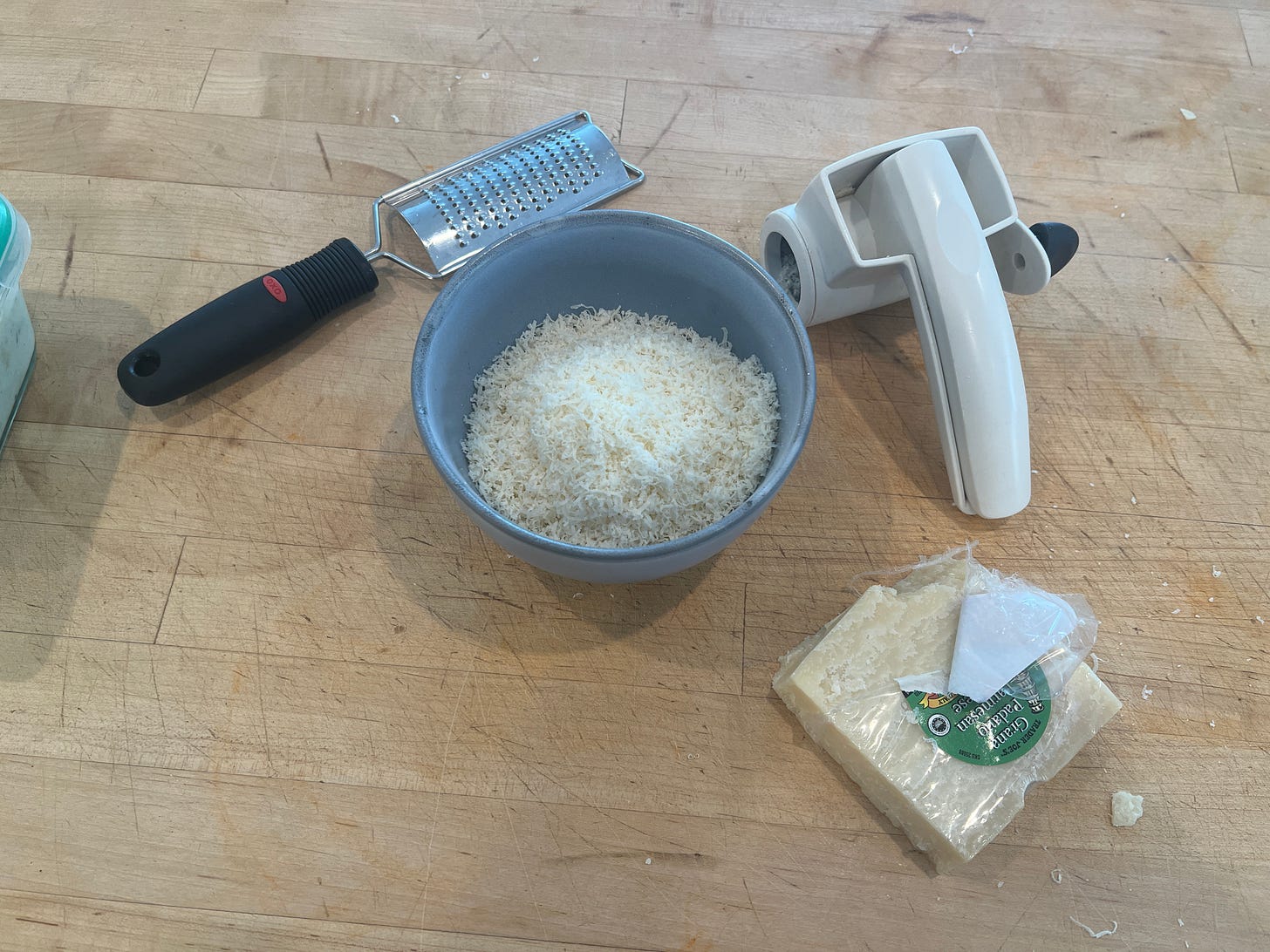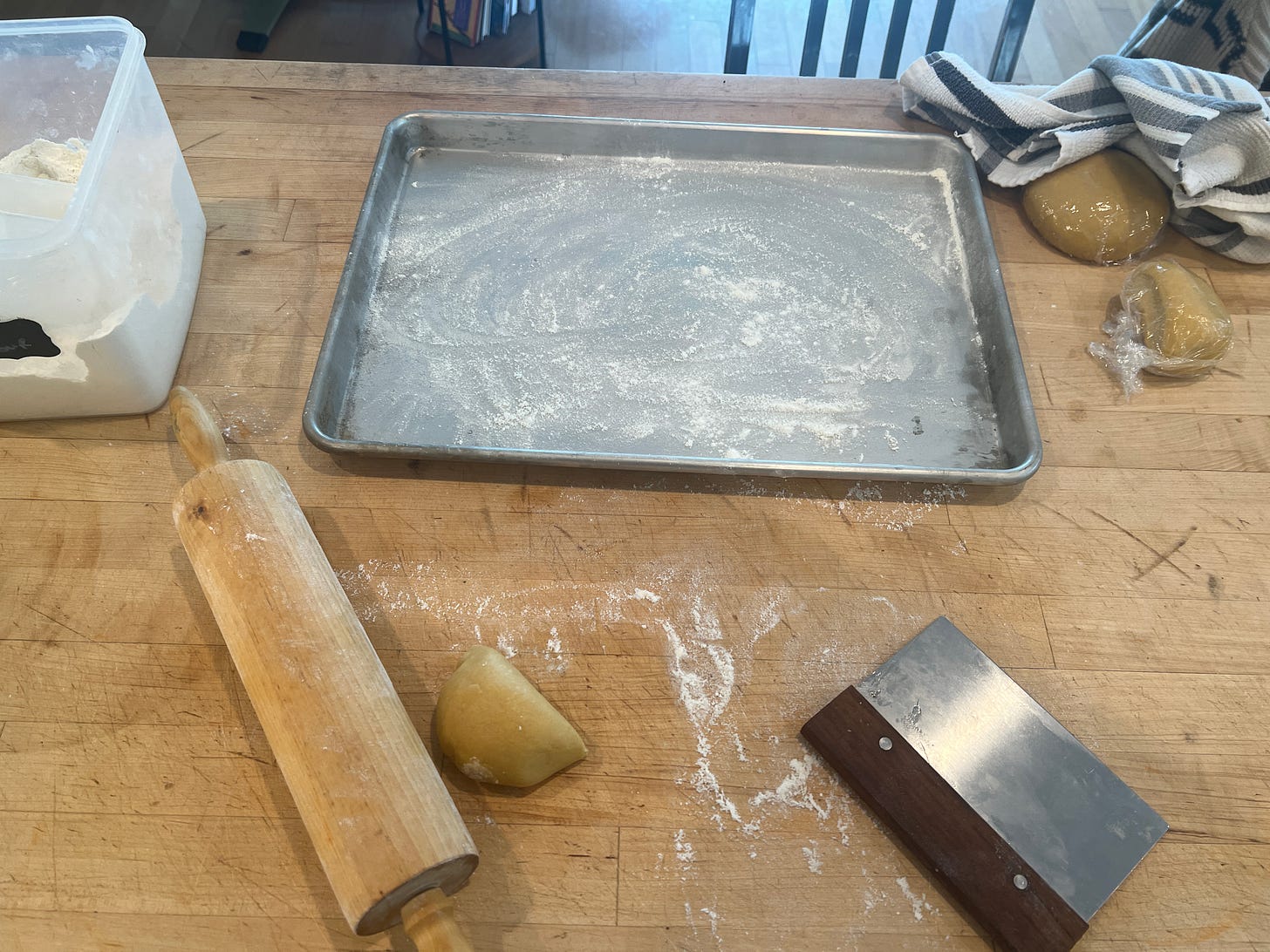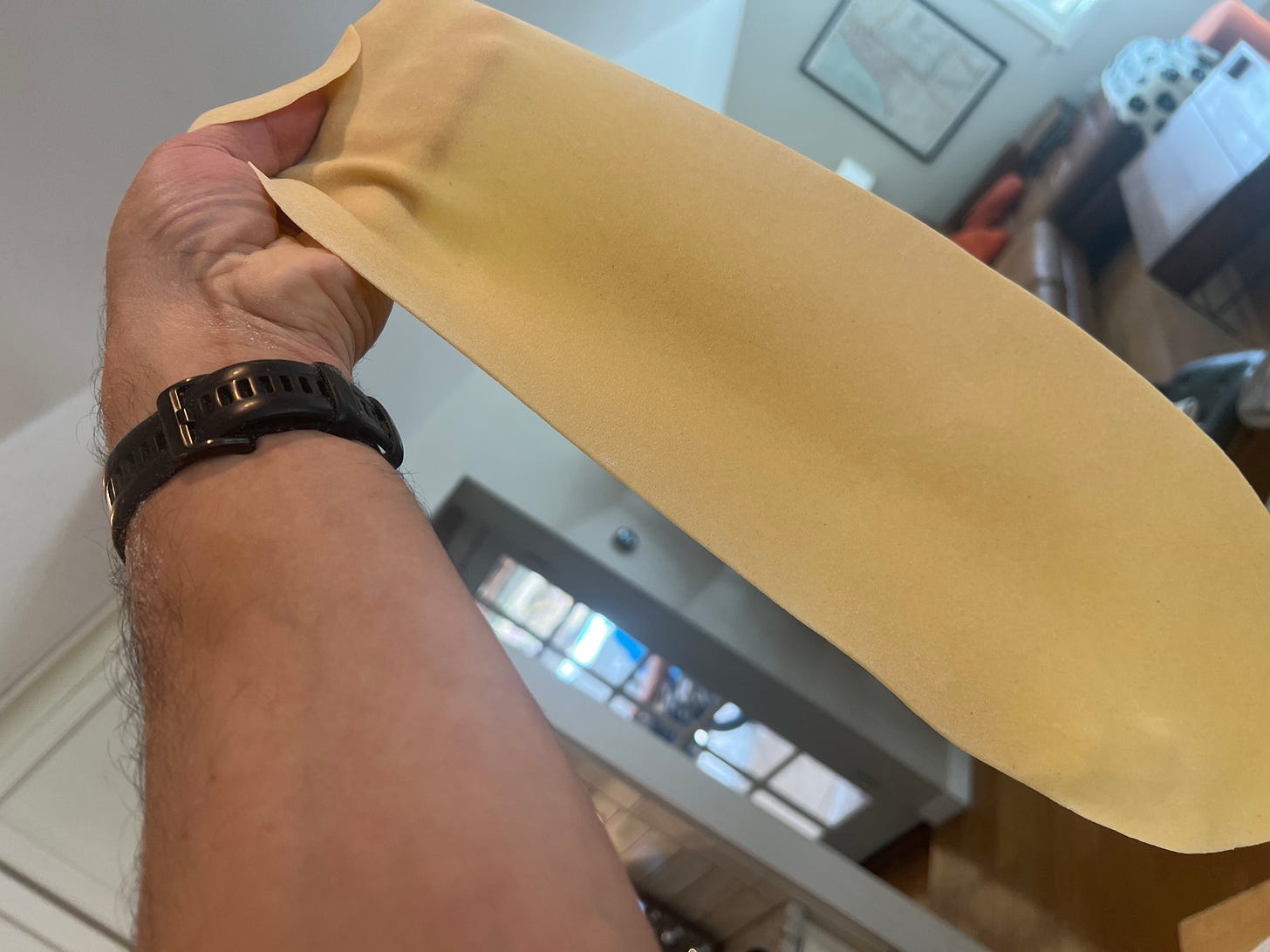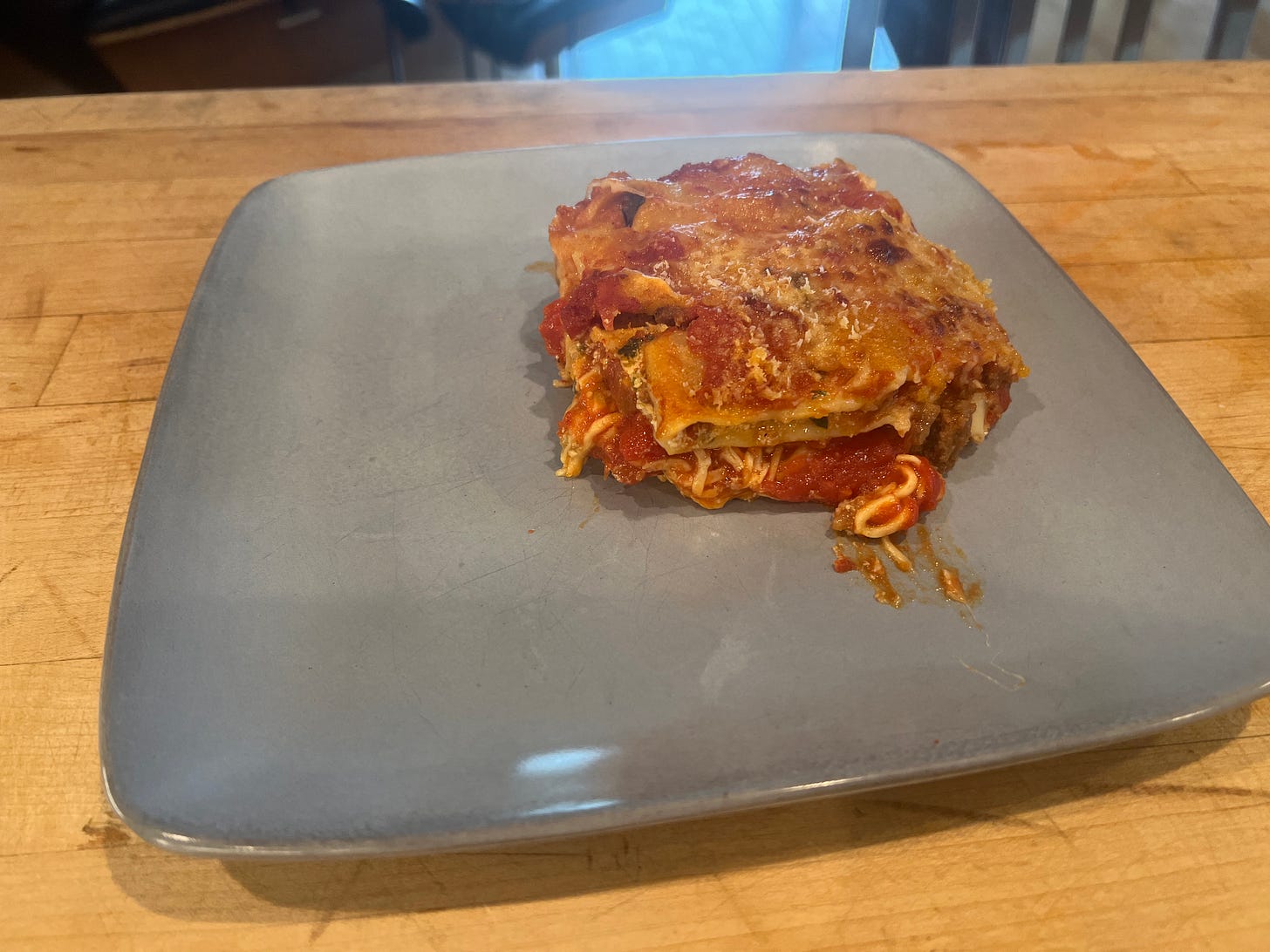A good lasagna can be had with some pasta sheets, meltable cheese, and lots of good tomato sauce. Pile them all together and bake in a hot oven and you’ll make a descent lasagna.
A heart-attack lasagna requires 20 years of recipe tinkering and a lot more work. I named it that because I’m sure if you exclusively consumed it for 30 days like that moron did in Super Size Me, you would clog your arteries and die full and happy.
Making the pasta from scratch might be going slightly overboard, but it’s easy to do and makes a big difference—try it at least once; sometimes your soul is worth prioritizing.
1. Gather your ingredients
For the Pasta
400g all-purpose flour (roughly 2.5 cups)
4 eggs, at room temperature
1 tablespoon olive oil
1 teaspoon salt
or
1 box (1lb.) of no-bake lasagna sheets
For the tomato sauce
Two large cans (56 Oz) peeled tomatoes, ideally San Marzano, or an equivalent mix of whatever tomatoes you got
1 small can tomato paste
1 cup olive oil
6 cloves garlic
Salt
For the meat sauce
1 lb. ground beef
1 medium onion
1 cup mushrooms (optional)
1/4 cup pine nuts (optional)
1 tablespoon olive oil
For the cheese sauce
1 lb. ricotta cheese
1/4 cup grated parmesan cheese
1 egg
1/2 lb. spinach leaves (optional)
1 whole garlic (optional)
And finally
1 lb. grated mozzarella
1/2 cup parmesan, for sprinkles
2. Make the sauces
There are a lot of sauces in this Lasagna. You can make them all a day or two ahead and keep them covered in the fridge.
Start by grating a lot of parmesan cheese
Tomato sauce
Follow my simple method from this recipe. Don’t worry about the onions, and feel free to use up whatever tomatoes you’ve got. If using fresh tomatoes, remove the cores.

Meat sauce
Heat a cast iron or frying pan on medium high. Chop the onion, add a tablespoon of olive oil to the pan and cook the onion and mushrooms for 5 minutes.
Add the ground beef, break it up, and cook while stirring occasionally with a spatula until it’s browned and you don’t see any pink, roughly another 7 minutes. Throw in the pine nuts in the last 2 minutes.
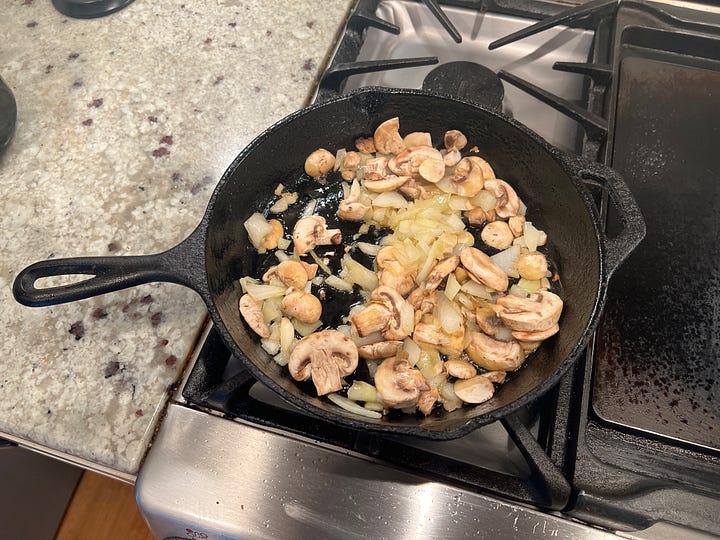

Ricotta sauce
Chop the top off the garlic, splash some olive oil, then cover tightly with aluminum foil. Roast at 375°F for 45 minutes. The cloves will turn golden brown and mushy. Unwrap and let cool.

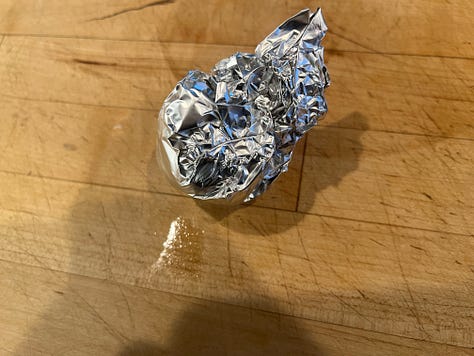
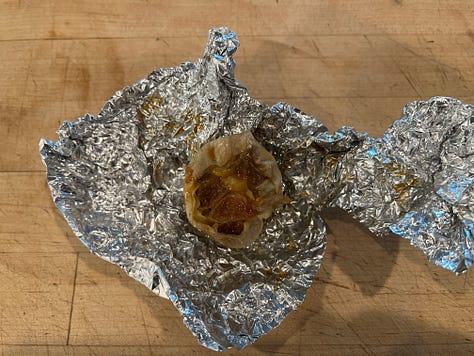
Wilt the spinach in a hot pan with a tablespoon of olive oil for 3-5 minutes.
Empty the ricotta cheese into a bowl, whisk the egg lightly and combine with the cheese.
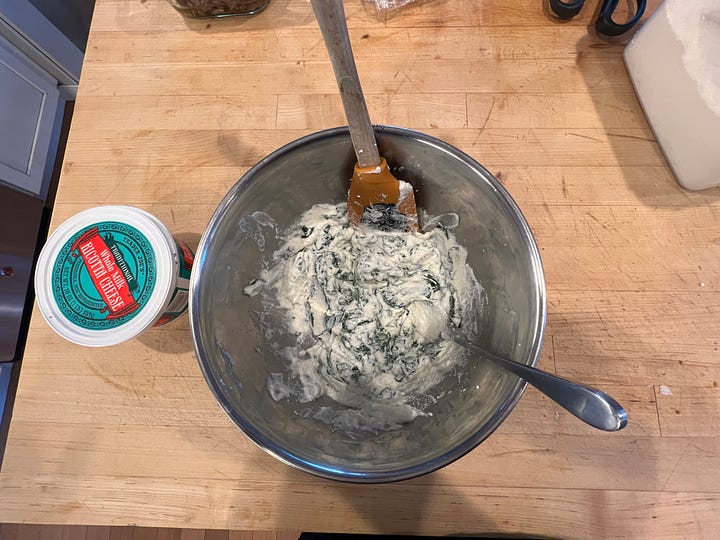

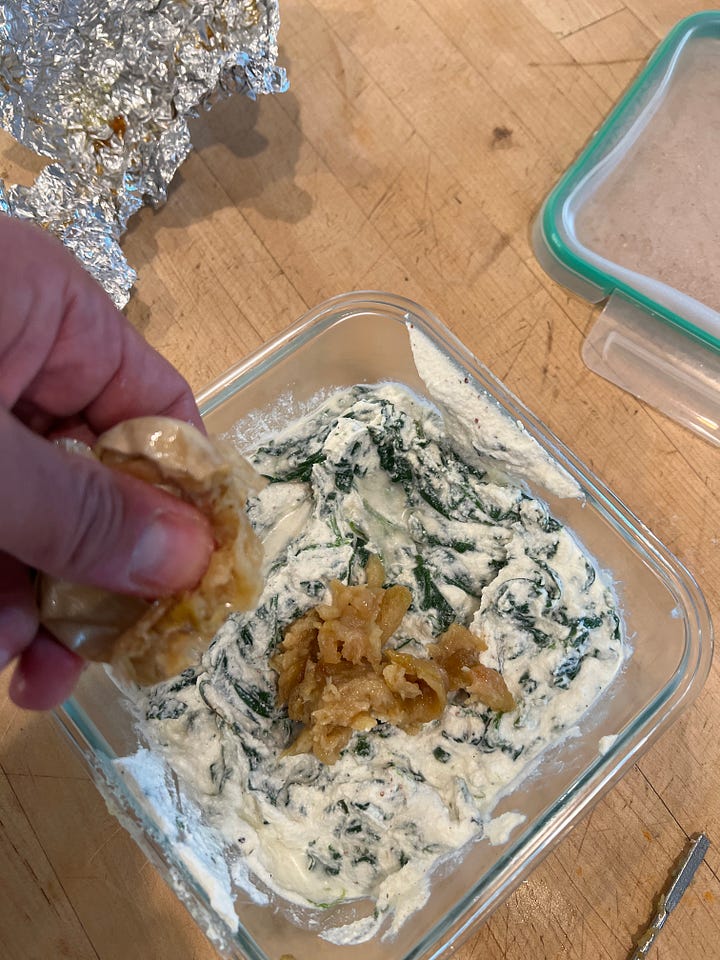
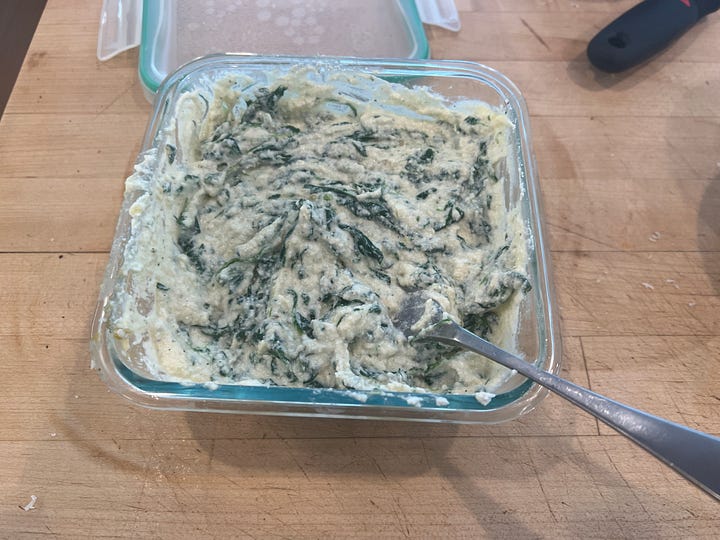
When the garlic has cooled down, squeeze it into the bowl, add the spinach, and stir everything with a fork to combine.
3. Make the Pasta
Pasta dough ratio of flour to liquid is 2:1. One medium cracked egg weighs roughly 50 grams so 400g flour to 4 eggs should work.
If you want to be absolutely sure, weigh the eggs, then use double the amount of flour.
The fastest way to make pasta (or any no-knead dough) is in a food processor.
Put the dry ingredients in first, whisk the eggs lightly then add them in with the olive oil and salt. Pulse slowly until the dough forms. It takes less than a minute. Stop and scrape down the sides if the dough bulges up.
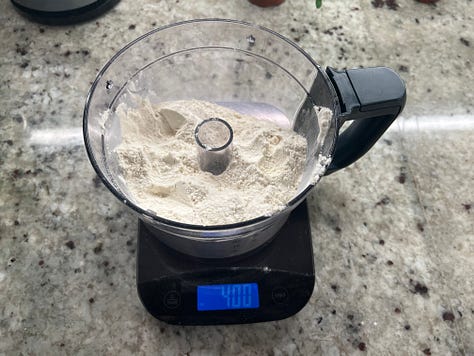
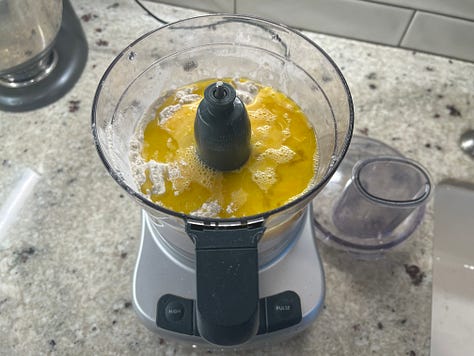



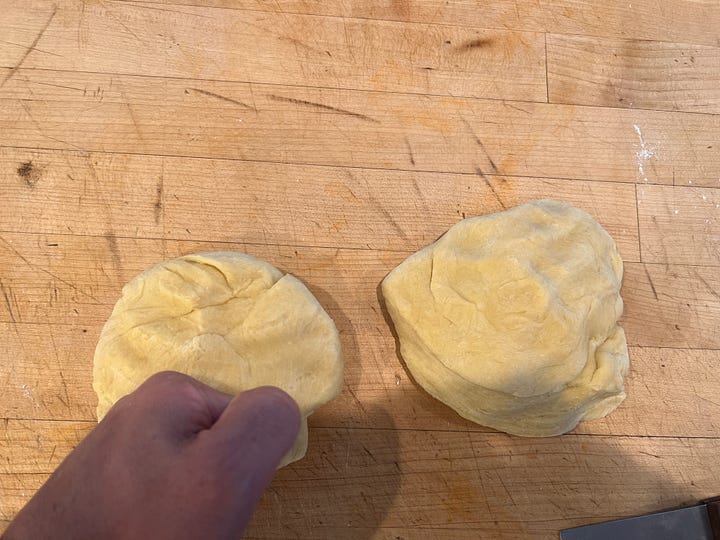

Clean your working surface and dust lightly with flour. Kneed the dough lightly, cut it in half, then cup each half with both hands to make a ball, and wrap tightly with plastic wrap. Let the dough rest on the counter for at least an hour, the longer it rests the it handles.
Start rolling only when all the sauces are made and cooled and you are ready to bake the lasagna
Unwrap the dough, divide in half again, and keep the un-attended pieces on a baking sheet covered with a clean dish towel.
If you have a pasta making machine, use it and follow the instructions for lasagna sheets.
If your don’t have one or couldn’t find the crank to your pasta roller (definitely an act of sabotage), you can still make good pasta with a rolling pin and your muscles.
I don’t worry too much about perfection or symmetry, it will all end up smothered in sauce and in my belly.
Your goal is to make the sheets as thin as you can without creating significant ruptures in the dough. If you make a hole, pinch it together and roll over it, then admire the scar you created.
Start by flattening the dough with your hands into as square of a shape as you can. Then start rolling from the middle out (away from you).
Rotate the dough and repeat until you flatten it on all sides, then pick a center line and roll half the dough at a time. Keep flipping the dough horizontally (180°) and rolling away from you. The dough will get thinner and lengthen as you do this.
Use some force, and let gravity help by letting the idle side hang off your work bench, if possible.

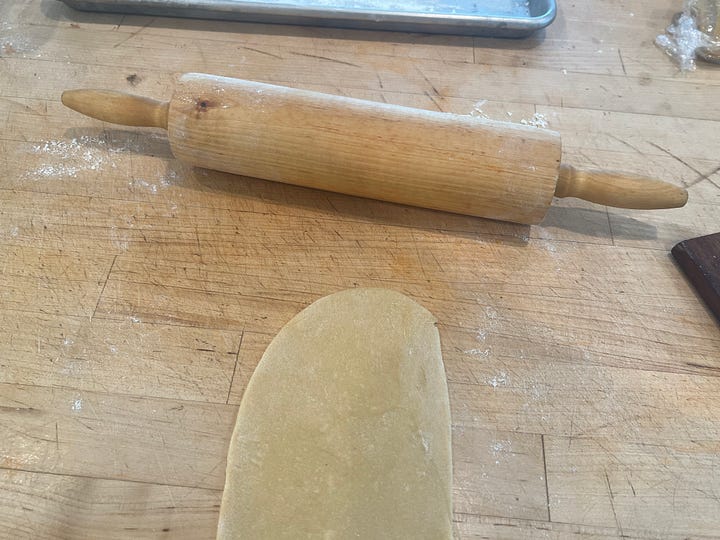
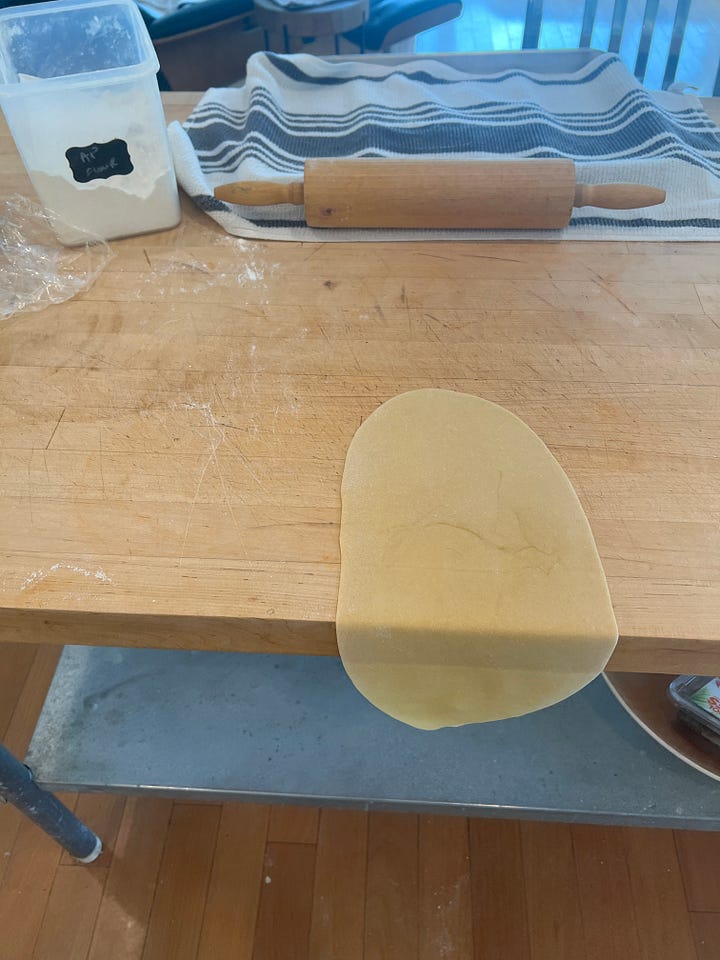
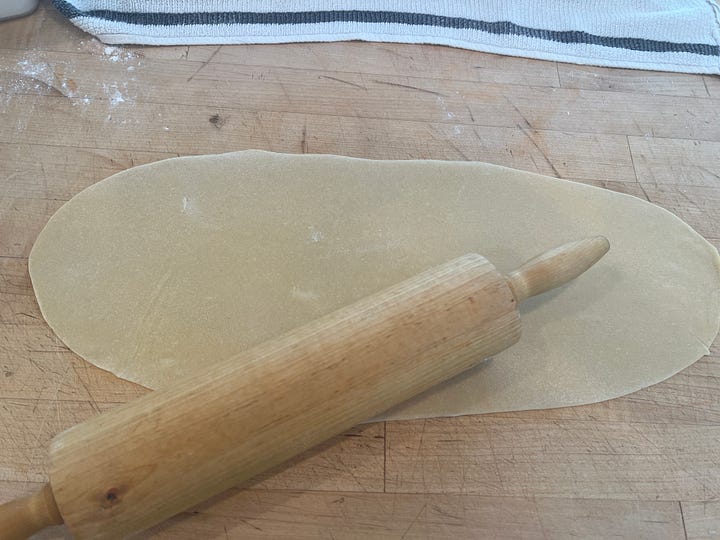
Keep going until you start seeing a bit of translucency. If the dough gets too long to manage cut it in half and keep working.
Always cover unhandled dough and keep some flour nearby in a bowl. If it ever gets sticky throw some flour on it.
When the dough is as flat as you can get it, sprinkle some flour on it and cover with a clean tea towel, then continue working with the other pieces until you’re done.
Cut the dough into equal sized rectangular sheets using a rolling pasta cutter or a very sharp knife. Make a dozen rectangles, and then make filler cuts.
You can start by measuring the sheet across your 13x8 baking dish and dividing it into equal parts.
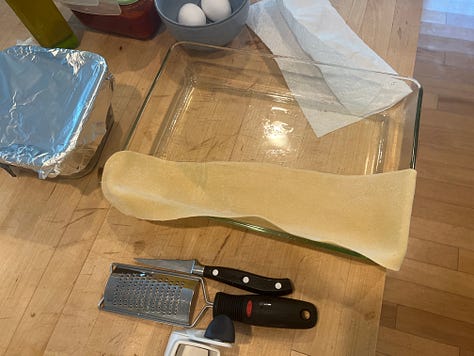
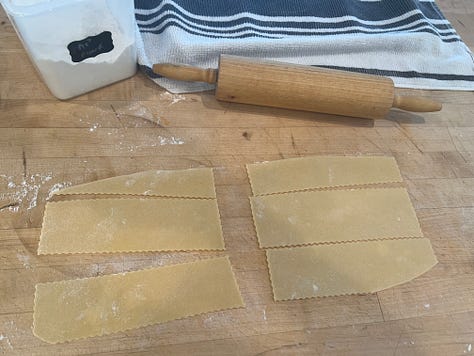

It really doesn’t matter as long as you have enough pasta to create at least three layers, as you can see from my highly asymmetrical cuts above.
You can also recombine the odd ends and re-roll into sheets, if you are so inclined.
Note: To make fettuccine, roll an uncut sheet into a cylinder, flatten it, then cut across to your desired thickness before unraveling the strands.
4. Layer the lasagna
Layering isn’t very complicated if you follow one simple rule: all pasta layers should be in contact with a sauce on both sides so they cook through.
Rub some olive oil onto a deep 13x8 inch baking dish. Combine some of the tomato sauce with the meat sauce to make it easier to spread.
Start with a splash of tomato sauce to lightly cover the bottom, then line the pasta sheets. Layer with ricotta sauce, then meat sauce, then tomato sauce, then mozzarella, and repeat.

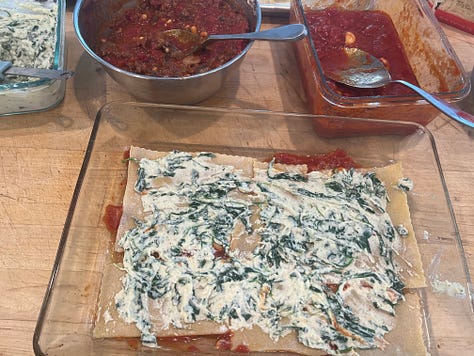
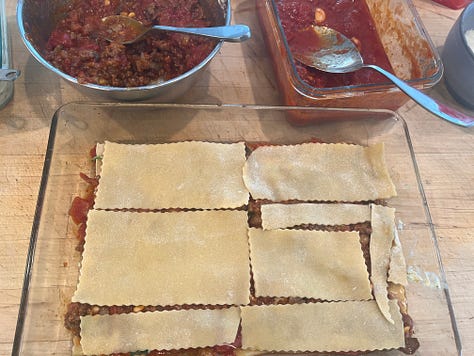
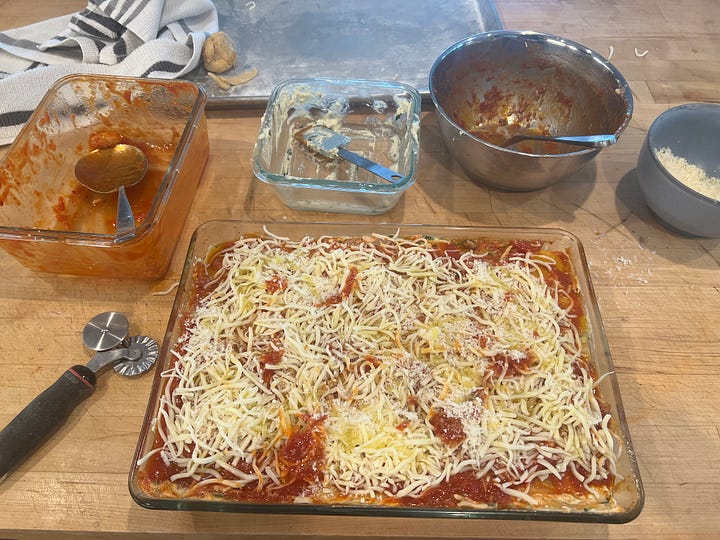
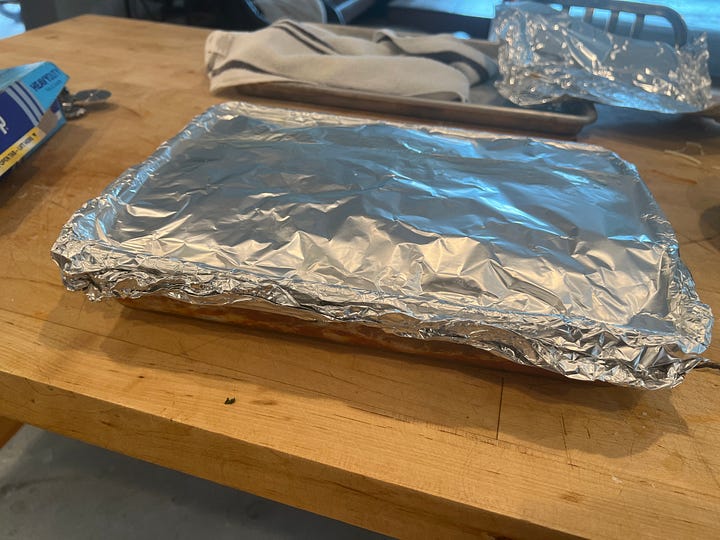
When you get to the third layer of pasta, check your inventory. If you’re almost out of sauces, cover the top layer with tomato sauce, sprinkle the last of the mozzarella and you’re done. If you still have enough go for a fourth layer.
You can also make life a little easier and use up all your meat sauce in one layer, the cheese sauce on then second, then continue with just the tomato sauce and mozzarella.
It doesn’t really matter as long as you follow the sauce contact rule and keep the sauce layers roughly even sized. I usually err on the side of excess tomato sauce to guarantee cooked pasta.
Leave a cup of mozzarella to sprinkle on the top before baking, finish with some grated parmesan if you like (I always do).
Cover tightly with aluminum foil and bake at 375°F for 40 minutes. Test for doneness by poking a knife through the pasta, it should easily go through.
Bake uncovered for another 5-10 minutes until the top layer of cheese is browned, or use the broiler on low but watch very carefully, it will brown in a couple of minutes.
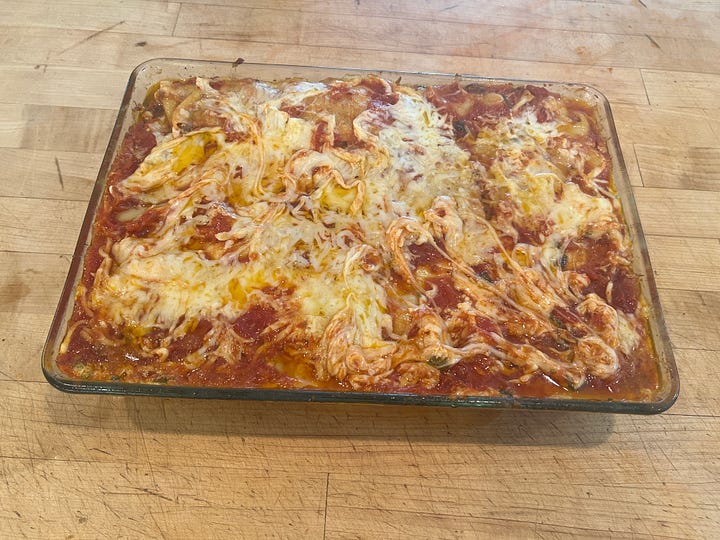

Let rest for at least 15 minutes before you cut into it.
5. Eat!
Serve giant pieces with Caesar salad and listen to your heart pumping harder with every bite.
6. Notes
Don’t let the pasta dry out while preparing. Always cover unused portions and use quickly.
Make other kinds of pasta. This is the same dough for noodles. Cut them up and boil them. They cook in 2-4 minutes and float to the top when ready. Coat them with tomato sauce or just olive oil and salt. They’re delicious.
Make it your own. If this feels like too much, it is. I highlighted all the optional ingredients. You can also skip the meat sauce, remove the spinach, ignore the roasted garlic, reduce the mozzarella, or go the other way and add even more cheeses, meats, zucchini, hot peppers, etc. Lasagna is like pizza, if you have good pasta and enough tomato sauce you can do whatever you want with it.





